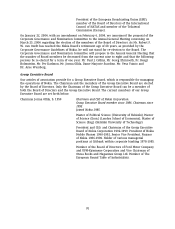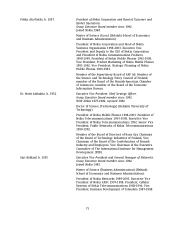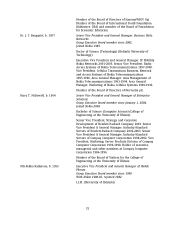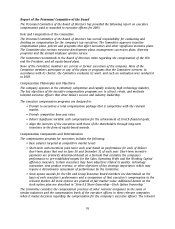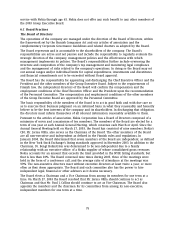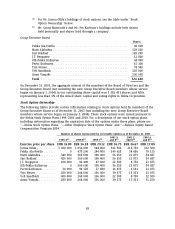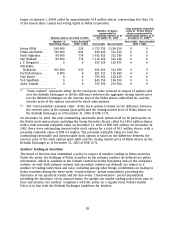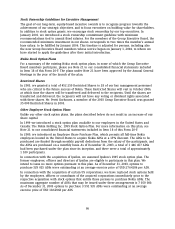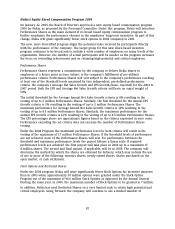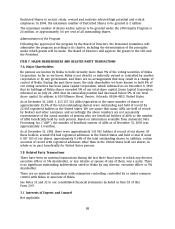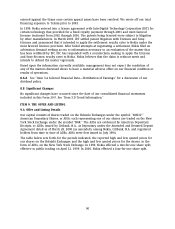Nokia 2003 Annual Report Download - page 81
Download and view the complete annual report
Please find page 81 of the 2003 Nokia annual report below. You can navigate through the pages in the report by either clicking on the pages listed below, or by using the keyword search tool below to find specific information within the annual report.Under Finnish law, if the roles of the Chairman and the Chief Executive Officer are combined, the
company must have a President. The responsibilities of the President are defined in the Finnish
Companies Act and other relevant legislation along with any additional guidance and instructions
given from time to time by the Board and the Chief Executive Officer. The responsibilities of the
Chief Executive Officer are determined by the Board.
The Board and each of its committees conducts annual performance self-evaluations, the results of
which are discussed in the committees, respectively, and in the full Board. The Corporate
Governance Guidelines concerning the directors’ responsibilities, the composition and selection of
the Board, Board committees and certain other matters relating to corporate governance are
available on our website, www.nokia.com.
We also have a company Code of Conduct which is equally applicable to all of our employees,
directors and management and is accessible at our website, www.nokia.com. As well, we have a
Code of Ethics for the Principal Executive Officers and the Senior Financial Officers. For more
information about our Code of Ethics, see ‘‘Item 16B. Code of Ethics.’’
In November 2003, the US Securities and Exchange Commission approved changes to the New York
Stock Exchange’s listing standards related to the corporate governance practices of listed
companies. Under these rules, listed foreign private issuers, like Nokia, must disclose any
significant ways in which their corporate governance practices differ from those followed by US
domestic companies under the NYSE listing standards. There are no significant differences in the
corporate governance practices followed by Nokia as compared to those followed by US domestic
companies under the NYSE listing standards, except that Nokia follows the requirements of Finnish
law with respect to the approval of equity compensation plans. Under Finnish law, stock option
plans require shareholder approval at the time of their launch. All other plans that include the
delivery of company stock in the form of newly issued shares or treasury shares require
shareholder approval at the time of the delivery of the shares or, if shareholder approval is
granted through an authorization to the Board of Directors, not earlier than one year in advance
of the delivery of the shares. The NYSE listing standards require that equity compensation plans be
approved by a company’s shareholders. Nokia’s corporate governance practices also comply with
the Corporate Governance Recommendation for Listed Companies approved by the Helsinki
Exchanges in December 2003.
Committees of the Board of Directors
The Audit Committee consists of a minimum of three members of the Board, who meet all
applicable independence, financial literacy and other requirements of Finnish law and applicable
stock exchange rules. Since March 27, 2003, the Committee has consisted of the following four
members of the Board: Messrs. Robert F.W. van Oordt (Chairman), Georg Ehrnrooth, Per Karlsson
and Arne Wessberg.
The Audit Committee is established by the Board primarily for the purpose of overseeing the
accounting and financial reporting processes of the company and audits of the financial
statements of the company. The Committee is responsible for assisting the Board’s oversight of
(1) the quality and integrity of the company’s financial statements and related disclosure, (2) the
external auditor’s qualifications and independence, (3) the performance of the external auditor
subject to the requirements of Finnish law, (4) the performance of the company’s internal controls
and risk management and risk audit function, and (5) the company’s compliance with legal and
regulatory requirements. The Committee also maintains procedures for the receipt, retention and
treatment of complaints received by the company regarding accounting, internal controls, or
auditing matters and for the confidential, anonymous submission by employees of the company of
concerns regarding accounting or auditing matters. Under Finnish law, our external auditor is
elected by our shareholders at the Annual General Meeting. The Audit Committee makes a
80


